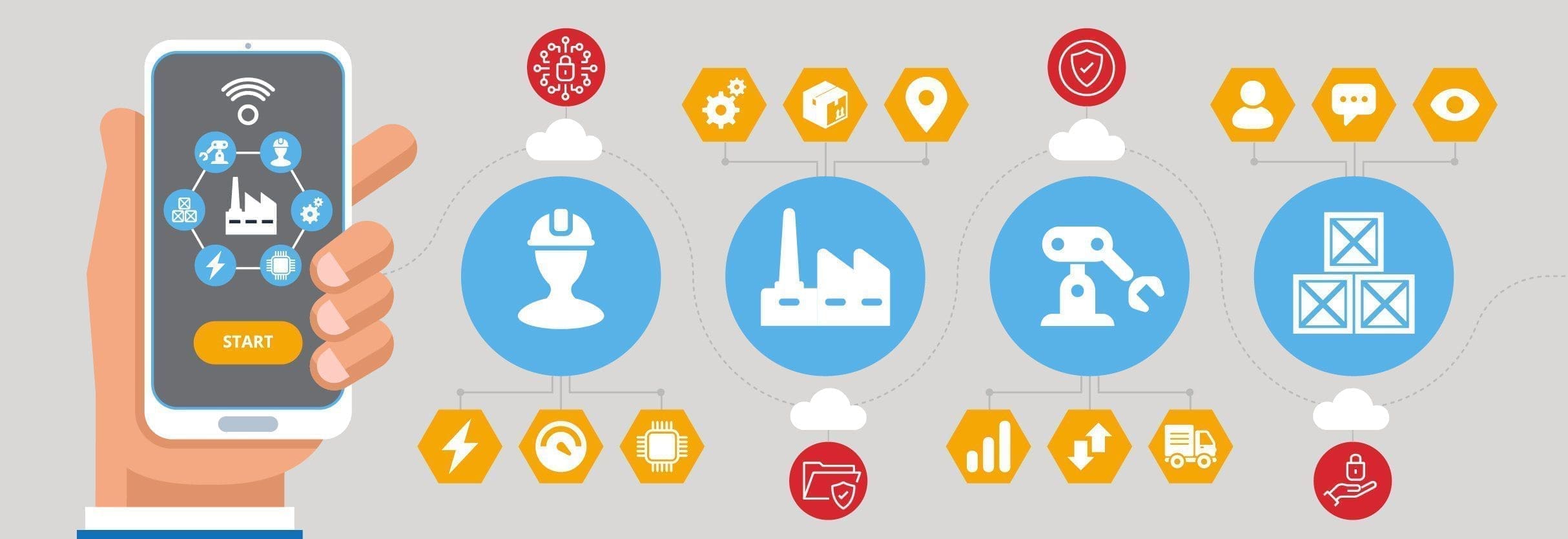

In this guide, we’ll provide an overview of IIot including what it is and how it’s used. We’ll also examine the various security concerns that arise from the growing IIoT and how to properly secure your IIoT devices using remote support solutions.
What is the Industrial Internet of Things (IIoT)?


What is the Difference Between IoT and IIoT?
The difference between IoT and IIoT is primarily a difference in scale. The internet of things usually refers to consumer devices, such as personal fitness trackers or smart thermostats. The industrial internet of things refers to equipment that is powering enterprise on a much larger scale, such as IIoT used in supply chain management.
While IoT can be used as an umbrella term to include all internet-enabled devices, industrial IoT is a targeted term meant to focus on more complex networks of devices intended to drive production.
How is IIoT Used in Manufacturing?
IIoT is used in manufacturing to increase efficiencies and maximize production. OEMs are creating more embedded devices that have IT functions to go along with their operational technology purposes. By compiling and analyzing data from these devices in real-time, manufacturers create what many are calling ‘smart factories.’
In this sense, IIoT has radically transformed manufacturing. What was once a highly fragmented industry can now be streamlined by incorporating IIoT devices. Let’s take a look at the ways in which IIoT creates efficiencies in manufacturing.
Efficiencies of IIoT in Manufacturing


- Predictive maintenance and repair
- Shorter time to market
- Increased customization
- Asset tracking along supply chains
- Optimal facility management
- Cost reductions
- Safer workplaces
- More user-friendly interfaces
Combining these types of functions with a secure remote support solution ensures that each IIoT device is functioning properly and not vulnerable to cyberthreats, leading to a more productive, efficient manufacturing environment, no matter how widely distributed the facilities are.
Security Concerns of the Industrial Internet of Things
The security concerns of IIoT stem from an increased attack surface and the need for remote access. As more devices and sensors come online, they create more communication channels, data stores, ports, and endpoints. This increased interconnectivity represents more vulnerabilities if left unprotected.
An overview of industrial IoT solutions is broken down into three categories: local area networks, data processing, and endpoint management.
Securing IIoT Local Area Networks (LAN)
Manufacturers and other IoT industrial users should take security seriously even within the confines of their LAN. While a smaller business might only have to configure somewhat uniform security measures across computers and servers, an IIoT facility will present unique challenges in the diversity of equipment in use in various locations.
Many IIoT devices weren’t built with optimal security baked in. Prioritizing security within an IIoT LAN will require that all your devices are protected from unauthorized access no matter what their operational technology function is.
Safe Data Transmission
Another potential vulnerability for IIoT manufacturing plants is the increase in data sharing across networks of IIoT devices and facilities.
As the amount of intelligent machinery continues to rise, more data stores and gateways are created that need to be secured. A sensitive data breach could result in safety hazards, equipment malfunction, or self denial-of-service downtime.
Secure Network Ports
Network ports can be at risk of attack if they aren’t properly configured, if they’re left open, or if poor authentication practices are in place. Data transmitted through these ports can be easily accessed by cyberattackers, and ports that are used often could be at greater risk, which is why it’s important to secure ports.
Secure User Endpoints
While some aspects of IIoT point to increased automation, there are still technicians, managers, and engineers who must interface with the equipment. These endpoints are prime targets for cybercrime.
If endpoints don’t have clearly defined user permissions and multi-factor authentication built-in, your network of IIoT devices is vulnerable to unauthorized activity and costly interruptions. Just as the retail industry must focus on POS security, endpoint management is critical to manufacturers trying to achieve optimal security.
Secure Remote Access: The Missing Link for OEMs


In order to ensure zero downtime on plant floors, OEMs and industrial control centers (ICS) are wise to integrate secure remote access software into their networks. Basic remote login apps such as RDP and VNC are not designed with IIoT compatibility and security in mind. RDP and VNC lack the security (especially when it comes to access control ad user authentication across networks) and intelligence that most OEM machinery requires. For proper OEM protection, a dedicated, fully scalable remote access software is what’s needed.
Many IIoT facilities are already taking note. A recent Kaspersky study revealed that over half of industrial organizations believe IoT will transform the way they view security, and 20% of organizations have already invested in IIoT security solutions.
On-Premise vs. Cloud Based Industrial IIoT Systems
It’s important to recognize that whether you employ an on-premise or cloud-based model of IIoT data storage and analytics, secure remote access will need to be a priority regardless.
Each model creates unique security concerns. For instance, while sensors and controllers may be confined to a single LAN, the technicians and users who consumer the data are increasingly off site. Your IIoT devices may be restricted to a LAN environment, but users travel so strong remote access security is still a must.
With a cloud-based model, your team might be able to focus more on optimal operational technology functionality of your devices since much of your IT might be outsourced to cloud-based apps. However, this creates a larger attack surface and more gateways that need to be secured.
It’s also noteworthy that cloud-based services aren’t just about data storage any longer. Now, a large part of cloud computing is active processing and analytics that can be performed on the cloud all the way up to the edge of your network, a practice called edge computing. Allowing the cloud to power processing that can still take place on or near your devices means quicker analysis and more actionable information is available to technicians and managers.
How to Ensure Secure Remote Access for IIoT Devices
Remote access software can not only mitigate risk but can also improve efficiency on the production floor. Here are just a few of the benefits of using remote access software in IIoT:
- Increased connectivity without increased vulnerability
- Reduced travel costs (thanks to remote monitoring and break-fix)
- Improved safety for employees
- Customization that drives productivity
- Extensive tracking and documentation
While some specific tactics of secure remote access are dependent on your production field, many strategies remain the hallmarks of remote access software no matter what industry you’re in.
Custom Authorization Levels


With so many users working on different types of devices in a manufacturing environment, it’s crucial to have the ability to set granular controls over user permissions. That way you know who has access, who doesn’t, and if there has been a breach in that access.
RDP and VNC offer limited access controls, especially for users outside the LAN. Choosing dedicated secure remote access software allows for the access and control customizations organizations need.
Multi-factor Authentication in IIoT Devices
Many of the smart devices tracking and powering manufacturing processes still lack basic security functions like strong passwords and software updates.
IIoT devices without adequate security controls should be segregated into special network segments where they can’t be used as a beachhead to attack other devices. Remote access software will then allow you to implement strong multi-factor authentication across the board. No device will be left unprotected. In addition to stronger authentication, devices can be checked for necessary patches and updates as needed.
End-to-end Encryption for Device Protection
Encryption refers to complex algorithms that divert unauthorized users trying to access sensitive data. Yet many of the incredibly consequential devices on a plant floor are sharing data without encryption, or at least without ample encryption.
Endpoint and gateway encryption give remote access software an advantage over cookie-cutter remote desktop apps. Backed by 256-bit encryption, data that is transmitted and stored by IIoT devices will be kept safe from cybercriminals.
Custom Solutions for Secure Remote Access: Impero Connect
With the industrial internet of things on the rise, many manufacturers are capitalizing on the opportunity to increase efficiency through improved cybersecurity. More uptime in a manufacturing organization means more productivity. And it’s not possible without airtight security measures to mitigate the risks of service interruptions.
For manufacturing and beyond, secure remote access is quickly becoming the key to maximizing output. No matter what industry you’re in, remote access allows you to work safely in and out of your local network. With Impero Connect, you can create a multi-tiered security solution that works for your enterprise and integrates seamlessly with your technology stack.
Impero Connect allows your organization to centralize remote access and connect across complex network environments. Fully scalable and flexible to the needs of your business, Impero Connect offers you premium security with unmatched efficiency. If you’re ready to commit to secure remote access from anywhere, start your free trial today!


